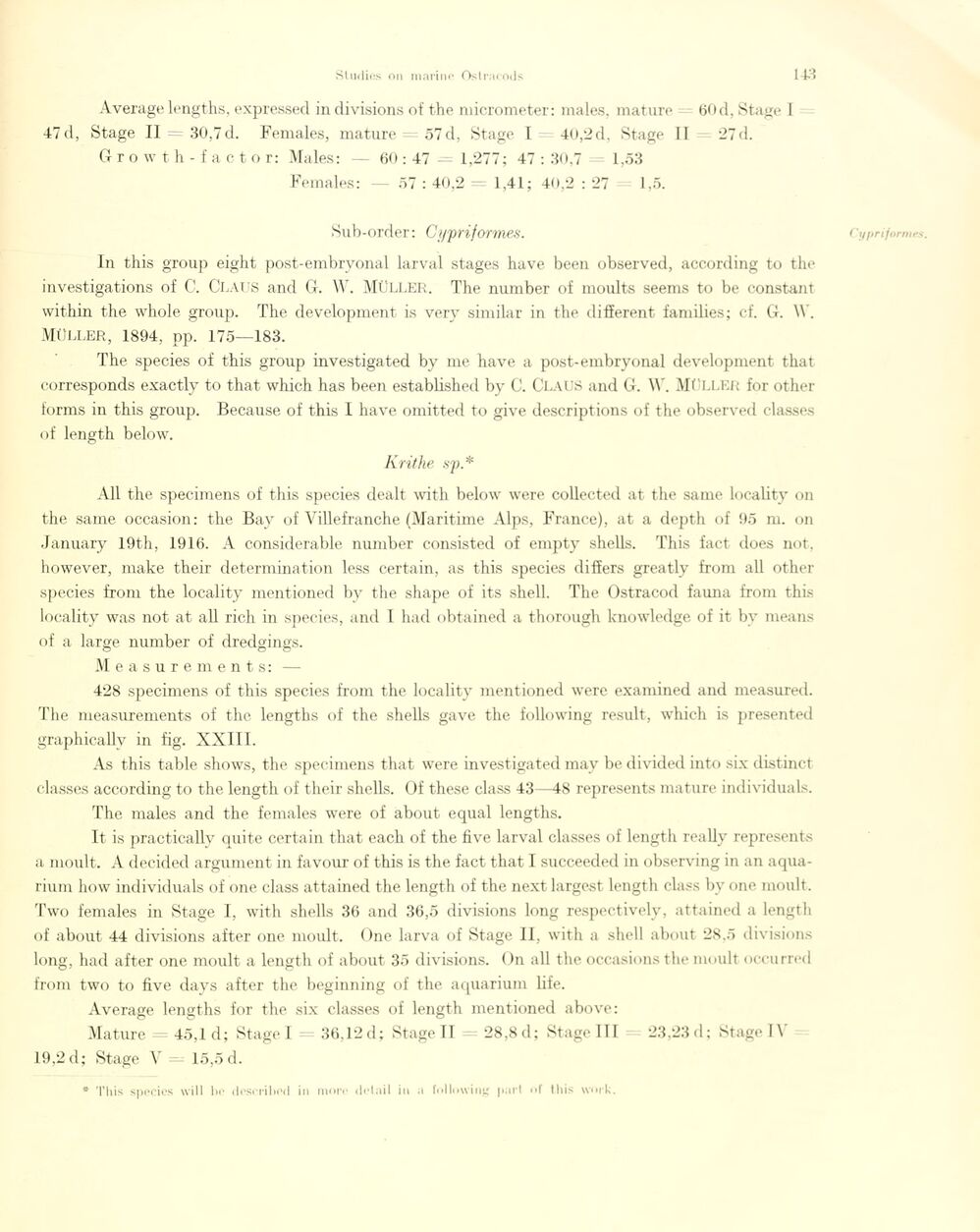
Full resolution (JPEG) - On this page / på denna sida - Sidor ...

<< prev. page << föreg. sida << >> nästa sida >> next page >>
Below is the raw OCR text
from the above scanned image.
Do you see an error? Proofread the page now!
Här nedan syns maskintolkade texten från faksimilbilden ovan.
Ser du något fel? Korrekturläs sidan nu!
This page has never been proofread. / Denna sida har aldrig korrekturlästs.
Average lengths, expressed in divisions of the micrometer: males, mature 60 d, Stage 1
47d, Stage II = 30,7d. Females, mature 57d, Stage I 40,2d, Stage II 27d.
Growth-factor: Males: — 60 : 47 — 1,277; 47 : 30,7 1,53
Females: — 57 : 40,2 = 1,41; 40,2 : 27 1,5.
Sub-order: Cypriformes.
In this group eight post-embryonal larval stages have been observed, according to the
investigations of C. Claus and G. W. Müller. The number of moults seems to be constant
vvithin the whole group. The development is verv similar in the different families; cf. G. W.
Müller, 1894, pp. 175—183.
The species of this group investigated by me hâve a post-embryonal development that
corresponds exactly to that which has been established by C. Claus and G. \V. Müller for other
forms in this group. Because of this I have omitted to give descriptions of the observed classes
of length below.
Krithe sp.*
All the specimens of this species dealt with below were collected at the same locality on
the same occasion: the Bay of Villefranche (Maritime Alps, France), at a depth of 95 m. on
January 19th, 1916. A considérable number consisted of empty shells. This faet does not,
however, make their determination less certain, as this species differs greatly from all other
species from the locality mentioned by the shape of its shell. The Ostracod fauna from this
locality was not at all rieh in species, and l had obtained a thorough knowledge of it by means
of a large number of dredgings.
© © ©
Measurements: —
428 specimens of this species from the locality mentioned were examined and measured.
The measurements of the lengths of the shells gave the following result, which is presented
graphicallv in fig. XXIII.
As this table shows, the specimens that were investigated may be divided into six distinct
classes according to the length of their shells. Of these dass 43—48 represents mature individuals.
The males and the females were of about equal lengths.
It is practically quite certain that each of the five larval classes of length really represents
a moult. A decided argument in fa vom of this is the faet that I succeeded in observing in an
aquarium how individuals of one dass attained the length of the nextlargest length dass by one moult.
Two females in Stage I, with shells 36 and 36,5 divisions long respectively, attained a length
of about 44 divisions after one moult. One larva of Stage II, with a shell about 28,5 divisions
long, had after one moult a length of about 35 divisions. On ail the occasions the moult occurred
from two to five days after the beginning of the aquarium life.
Average lengths for the six classes of length mentioned above:
Mature 45,1 d; Stage I 36,12d; Stage II 28,8d; Stage III 23,23d; Stage I\
19,2 d; Stage Y — 15,5 d.
Cypri formas.
’Pliis species will he deseri hed in more delail io a following part nf this work.
<< prev. page << föreg. sida << >> nästa sida >> next page >>